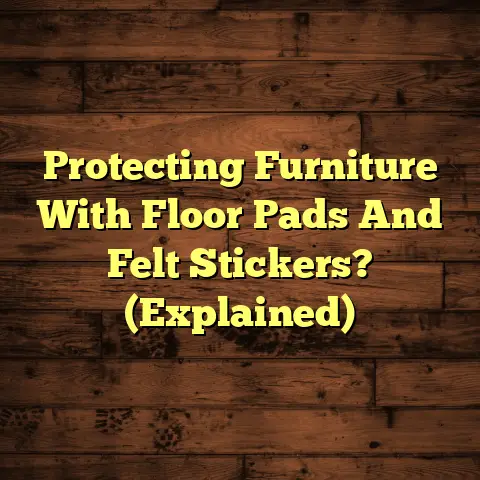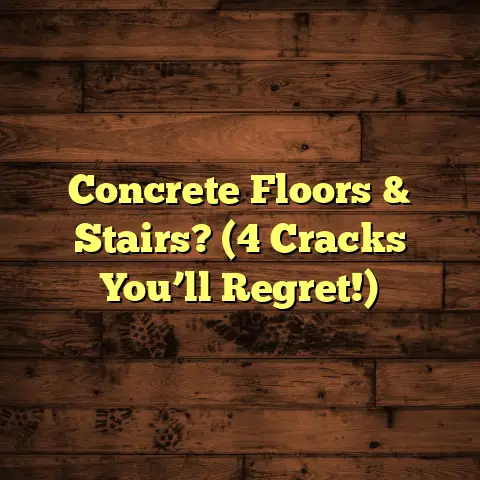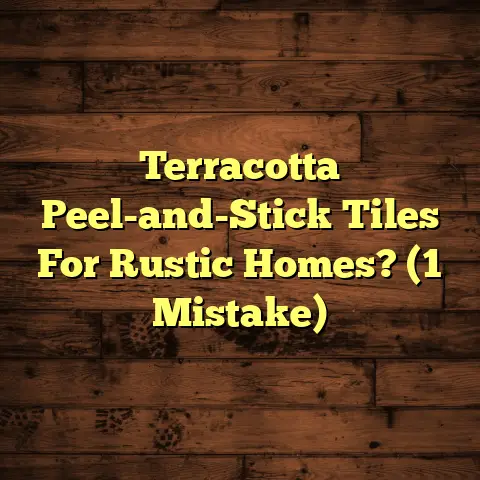Home Sale Prep: Flooring? (5 Value Boosts!)
It’s a wild ride, isn’t it?
You’re juggling staging, repairs, and the emotional rollercoaster of saying goodbye.
One of the biggest head-scratchers?
Flooring. Do you sink money into new floors, or just give the old ones a good scrub?
I’ve seen it all in my years as a flooring contractor.
Buyers notice the floors. Scratches, stains, that outdated linoleum?
It screams “project” and can kill a deal faster than you think.
But is new flooring always the answer?
That’s what we’re diving into. I’m going to break down the five key ways that addressing your flooring can seriously boost your home’s value.
Let’s get started!
1. First Impression: The Entryway Matters
Think about it: the entryway is the handshake of your home.
It’s the very first thing buyers see when they walk in.
A worn-out, dated entryway floor?
That’s a weak handshake, and it sets a negative tone right away.
I’ve seen homes where the entire vibe shifted just by updating the entryway flooring.
What works?
-
Hardwood: Classic, timeless, and always a winner. It gives an instant feeling of quality.
-
Tile: Durable and stylish, especially in areas prone to moisture like mudrooms.
-
Laminate: A budget-friendly option that can mimic the look of hardwood or tile surprisingly well.
I remember one house where the entryway had this awful, cracked vinyl.
We replaced it with a beautiful, dark-stained oak laminate.
Suddenly, the whole house felt more modern and inviting.
The buyers even commented on how much they loved the floors!
Don’t underestimate the power of that first impression.
It can make or break a buyer’s perception of your entire home.
2. Durability and Longevity: The Investment Factor
Buyers aren’t just looking for a pretty house.
They’re looking for a sound investment.
And flooring plays a big part in that.
Think about it: are they going to want to replace the floor after 5 years?
The quality of your flooring directly impacts the long-term value of your home.
Let’s break down some common materials:
| Flooring Type | Perceived Value | Durability | Lifespan |
|---|---|---|---|
| Hardwood | High | High | 25-100+ yrs |
| Laminate | Medium | Medium | 10-20 yrs |
| Tile | High | Very High | 75+ yrs |
| Carpet | Low | Low | 5-15 yrs |
Data based on my 20+ years in the field and industry averages.
Hardwood is always a solid choice. It’s durable, beautiful, and can last for generations with proper care.
Tile is another great option, especially in bathrooms and kitchens. It’s virtually indestructible and adds a touch of elegance.
Laminate is a budget-friendly alternative that can look surprisingly good, but it doesn’t have the same lifespan or perceived value as hardwood or tile.
Carpet? Honestly, it’s the least desirable option for most buyers.
It’s prone to stains, wear and tear, and can harbor allergens.
I’ve seen many buyers specifically request hardwood or tile instead of carpet.
ROI (Return on Investment):
Upgrading to hardwood can give you a ROI of 70-80%
Upgrading to tile can give you a ROI of 60-70%
Upgrading to laminate can give you a ROI of 50-60%
Data based on my 20+ years in the field and industry averages.
3. Trends and Aesthetics: Modern Appeal
Let’s face it: nobody wants to buy a house that looks like it’s stuck in the 1970s.
Flooring trends change, and outdated floors can really drag down the overall look of your home.
What’s hot right now?
-
Wide-plank hardwood: Creates a more open and modern feel.
-
Light-colored flooring: Brightens up the space and makes it feel larger.
-
Waterproof flooring: Especially popular in kitchens and bathrooms.
-
Wood-look tile: Offers the beauty of wood with the durability of tile.
Color is also key. Neutral tones like grays, beiges, and light browns are always a safe bet.
They appeal to a wider range of buyers and allow them to easily personalize the space with their own furniture and decor.
I once worked on a house that had this bright orange shag carpet.
It was…memorable, to say the least.
We ripped it out and replaced it with a light gray laminate.
The difference was night and day.
The house felt instantly more modern and stylish, and it sold within a week.
Don’t be afraid to embrace current trends.
It can make a huge difference in how buyers perceive your home.
4. Maintenance and Cleanliness: A Selling Point
A clean and well-maintained home signals that you care about your property.
And that includes the floors.
Buyers will be looking for any signs of neglect, so it’s important to address any flooring-related issues before you put your house on the market.
Here are some tips for keeping your floors in top shape:
-
Regular cleaning: Vacuum or sweep regularly to remove dirt and debris.
-
Professional cleaning: Consider hiring a professional to deep clean your carpets or hardwood floors.
-
Repair any damage: Fix any cracks, chips, or scratches.
-
Address stains: Remove any stains as soon as possible.
I always tell my clients to pay special attention to areas that get a lot of traffic, like hallways and entryways.
These areas are more prone to wear and tear, so it’s important to keep them looking their best.
And don’t forget about pet odors!
If you have pets, be sure to thoroughly clean your carpets and floors to remove any lingering smells.
I remember one house that smelled so strongly of cat urine that buyers couldn’t even make it past the entryway.
Don’t let that be your house!
A clean and well-maintained floor is a huge selling point.
It shows that you’ve taken good care of your home and that it’s ready for its new owners.
5. Creating a Cohesive Flow: The Importance of Consistency
Imagine walking through a house where the flooring changes drastically from room to room.
It’s jarring, right?
It can make the house feel disjointed and smaller than it actually is.
Consistent flooring choices throughout the home create a unified appearance and a sense of flow.
This is especially important in open-concept homes, where the flooring is visible from multiple rooms.
How to achieve a cohesive flow:
-
Choose a consistent color palette: Stick to neutral tones that complement each other.
-
Use similar materials: If you have hardwood in the living room, consider using hardwood or wood-look laminate in the bedrooms.
-
Pay attention to transitions: Use transition strips to create a smooth transition between different flooring types.
I always advise my clients to think about the overall design of their home when choosing flooring.
Do you want a modern look? A traditional look?
Choose flooring that complements your home’s style and creates a cohesive feel.
I once worked on a house where the owners had used a different type of flooring in every single room.
It was a disaster!
We replaced all the flooring with a consistent hardwood throughout the main living areas.
The house felt instantly more spacious and inviting, and it sold for significantly more than the owners were expecting.
Consistency is key.
It creates a sense of harmony and makes your home feel more pulled together.
Conclusion: The Impact of Flooring on Home Sales
So, there you have it.
Five ways that addressing your flooring can seriously boost your home’s value.
From making a strong first impression to creating a cohesive flow, flooring plays a crucial role in attracting buyers and getting the best possible price for your home.
I’ve seen firsthand how much of a difference it can make.
Don’t underestimate the power of a good floor.
It can be the difference between a quick sale and a house that sits on the market for months.
So, take a good look at your floors.
Are they helping or hurting your chances of selling?
If they’re looking a little worn, consider investing in some upgrades.
It could be the best investment you make in your home sale preparation.
Good luck!





